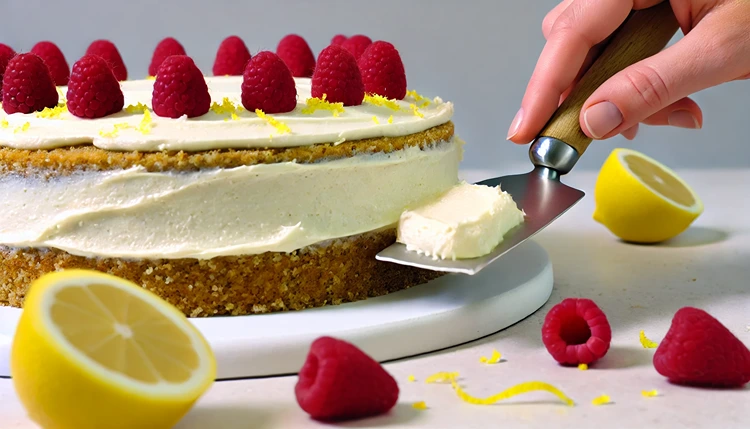If you’re looking for a fresh and tangy dessert, this vegan lemon raspberry cake with coconut frosting will hit the spot. Whether you’re planning for a special occasion or just want to satisfy your sweet tooth, this cake blends the bright flavors of lemon with the subtle sweetness of raspberries. It’s entirely plant-based, so you can enjoy it guilt-free while impressing your friends with its moist texture and irresistible coconut frosting.
This cake is all about flavor and balance, but it’s also a great recipe for those who are new to vegan baking. You won’t need any fancy or hard-to-find ingredients—just the basics, and some creative twists on traditional recipes.
Why Choose Vegan Lemon Raspberry Cake?
Why go for a lemon raspberry cake, and why vegan? First off, lemon and raspberry are a match made in dessert heaven. The tartness of the lemon is balanced by the sweet, slightly tangy raspberries, making for a light yet flavorful cake. The vegan part? It’s kinder to animals, easier on the planet, and often better for your health. Plus, you can enjoy all the deliciousness without missing out on the creamy texture that eggs or dairy would typically bring to a traditional cake.
How to Make a Moist Vegan Lemon Raspberry Cake?
The key to a moist vegan cake is using the right combination of ingredients. You want something that provides the lift and structure typically given by eggs, but without using any animal products. Luckily, there are plenty of great substitutes.
- Flax Eggs: Ground flaxseed mixed with water creates a gel-like consistency that acts as a binder and helps your cake stay moist.
- Applesauce: Unsweetened applesauce is an amazing way to keep your cake soft and moist. Plus, it adds a touch of natural sweetness.
- Plant-Based Milk: Almond milk, oat milk, or soy milk work well to create a fluffy texture. Just make sure it’s unsweetened to avoid altering the taste.
- Coconut Oil: This is your go-to for fat, which will keep your cake from being too dry.
Helpful Hint:
To bring out the lemon flavor even more, consider adding lemon zest along with the juice. The zest has concentrated oils that give an intense citrus aroma and taste.
Tips for Perfect Vegan Lemon Raspberry Cake
| Step | Key Tip | Why It Matters |
|---|---|---|
| 1. Measuring ingredients | Use a kitchen scale for accurate measurements. | Accurate measurements ensure consistent texture and prevent dryness or sogginess. |
| 2. Folding raspberries | Fold berries gently into the batter. | Prevents raspberries from breaking and releasing excess moisture into the cake. |
| 3. Cooling the cake | Let the cake cool completely before frosting. | Prevents the frosting from melting and sliding off the cake. |
| 4. Cake storage | Store the cake in an airtight container at room temperature or in the fridge. | This keeps the cake fresh and prevents it from drying out. |
| 5. Frosting consistency | Use chilled coconut cream for a thick, stable frosting. | Chilled coconut cream holds its shape better, especially for layered cakes. |
Key Ingredients for the Best Vegan Lemon Raspberry Cake
Here’s what you’ll need to create the perfect vegan lemon raspberry cake. Don’t worry—these ingredients are easy to find, and some might already be in your pantry.
- All-Purpose Flour: Standard flour works great here, but you can substitute with gluten-free flour if needed. Just make sure to use a 1:1 gluten-free baking flour for the best results.
- Baking Powder and Baking Soda: These are essential for giving your cake the lift it needs to stay light and fluffy.
- Lemon Juice & Zest: Fresh lemon juice is ideal for that bright flavor, and the zest enhances the lemony kick.
- Raspberries: Fresh or frozen raspberries will both work, but fresh berries tend to hold up better when baked.
- Plant-Based Milk: Any unsweetened plant milk will do, but almond milk tends to blend really well with the lemon flavor.
- Maple Syrup or Agave: Use these natural sweeteners to keep the cake lightly sweet and moist. They also blend perfectly with the tart lemon and raspberries.
Why Coconut Frosting?

Coconut frosting is the ideal match for this lemon raspberry cake. It’s rich but not too heavy, and it has a subtle coconut flavor that pairs beautifully with the fruitiness of the cake. Plus, it’s super easy to make!
How to Make Vegan Coconut Frosting?
Coconut frosting is surprisingly simple and requires just a few ingredients. You’ll need:
- Coconut Cream: This is the thick part that separates when you refrigerate a can of full-fat coconut milk. It gives the frosting a rich, creamy texture.
- Powdered Sugar: To sweeten the frosting without overpowering the coconut flavor.
- Vanilla Extract: A dash of vanilla enhances the overall flavor of the frosting.
For best results, make sure to chill your coconut cream for at least 24 hours before making the frosting. This ensures that it stays thick and easy to whip.
Helpful Hint:
If you want your frosting to have a stronger coconut flavor, consider adding a teaspoon of coconut extract. This will really make the coconut shine without needing any extra ingredients.
Now that you’ve got all your ingredients, let’s walk through how to make this amazing cake from scratch. The steps are easy to follow, and even if you’re a beginner at vegan baking, you’ll get great results.
Vegan Lemon Raspberry Cake with Coconut Frosting
Ingredients
- 1 ½ cups all-purpose flour
- 1 teaspoon baking powder
- ½ teaspoon baking soda
- ¼ teaspoon salt
- ½ cup unsweetened applesauce
- ⅓ cup melted coconut oil
- ⅔ cup coconut sugar or granulated sugar
- ⅔ cup almond milk (unsweetened)
- 2 tablespoons lemon juice
- 1 tablespoon lemon zest
- 1 cup fresh raspberries
Instructions
- Preheat your oven to 350°F (175°C). Grease a 9-inch cake pan and line it with parchment paper.
- In a large bowl, whisk together the flour, baking powder, baking soda, and salt.
- In a separate bowl, mix the applesauce, melted coconut oil, coconut sugar, almond milk, lemon juice, and lemon zest until well combined.
- Gradually add the wet ingredients to the dry ingredients, stirring until just combined. Be careful not to overmix.
- Gently fold in the raspberries, taking care not to crush them.
- Pour the batter into your prepared cake pan and bake for 25-30 minutes, or until a toothpick inserted in the center comes out clean.
- Allow the cake to cool completely before frosting with coconut frosting.
Nutritional Information
- Calories: 280 per slice
- Protein: 3g
- Carbohydrates: 34g
- Fat: 14g
- Sugar: 16g
How to Achieve the Perfect Cake Texture?
Getting the texture just right is key to making a vegan cake that stands out. No one likes a dry, crumbly cake, and thankfully, there are a few tricks that will ensure your vegan lemon raspberry cake stays moist and fluffy without relying on eggs or dairy.
1. Use the Right Balance of Wet and Dry Ingredients
One of the most important factors is keeping the wet and dry ingredients balanced. Too much flour can make your cake dense, while too much liquid can lead to a soggy mess. Stick to the measurements provided in the recipe, and remember that even small deviations can affect the final texture.
2. Don’t Overmix the Batter
When you’re combining the wet and dry ingredients, it’s important to mix them gently. Overmixing can lead to a tough, rubbery cake because it activates the gluten in the flour. The goal is to stir until the ingredients are just combined and you no longer see dry spots of flour—no more, no less.
3. Fold in Raspberries Carefully
Raspberries are delicate and can easily break apart, releasing extra moisture into the batter. To avoid a soggy cake, gently fold the raspberries into the batter using a spatula, rather than stirring them in with force. This will help keep the fruit intact, so they create juicy pockets of flavor throughout the cake.
4. Bake at the Right Temperature
Baking your cake at 350°F (175°C) is the sweet spot. Too high, and the edges of the cake will cook before the center has time to fully rise. Too low, and your cake could become dense or take too long to bake, leading to a dry texture. Always preheat your oven, and use the middle rack for even baking.
What to Do if Your Cake Turns Out Too Dry?
Sometimes, despite your best efforts, things don’t go exactly as planned. If your cake turns out too dry, don’t worry—you can still salvage it.
- Add a Simple Syrup: Make a quick simple syrup by combining equal parts sugar and water, heating until the sugar dissolves. Drizzle this over your cake layers while they’re still warm, and it will soak up the moisture.
- Serve with Extra Frosting: If your cake is a little dry, you can make up for it by adding a thicker layer of coconut frosting. The extra creaminess will balance out the texture.
- Pair with Vegan Ice Cream: Serving your cake with a scoop of dairy-free vanilla ice cream can add that missing moisture, making each bite rich and delicious.
Helpful Hint:
If you’re worried about a dry cake, you can also increase the fat content slightly by adding an extra tablespoon of melted coconut oil. This will help keep the cake moist without altering the flavor.
Creative Variations for Your Vegan Lemon Raspberry Cake
Once you’ve mastered the basic recipe, it’s fun to experiment with different flavors and textures. Here are a few ideas to put your own twist on this lemon raspberry cake:
1. Lemon Poppy Seed Raspberry Cake
Add a tablespoon of poppy seeds to the batter for a delightful crunch. The mild nuttiness of the seeds complements the citrusy lemon and sweet raspberries perfectly. It’s a small tweak that adds texture and visual appeal to the cake.
2. Lemon Blueberry Cake
Swap out the raspberries for fresh or frozen blueberries for a more mellow, sweet flavor. Blueberries also tend to hold their shape better during baking, giving your cake a nice pop of color and flavor without making it too tart.
3. Coconut Lemon Cake
If you’re a big fan of coconut, add shredded coconut to the batter and mix it with the frosting. The coconut inside the cake adds a chewy texture, while the frosting amps up the tropical vibe. This version pairs especially well with the lemon’s bright flavor.
4. Almond Lemon Raspberry Cake
For a slightly nutty flavor, swap some of the flour for almond flour. This not only adds richness but also gives the cake a slightly denser, more decadent texture. Plus, lemon and almond are a classic flavor combination that works beautifully together.
How to Store Vegan Lemon Raspberry Cake
If you have leftovers (which is unlikely with how delicious this cake is), you’ll want to store your vegan lemon raspberry cake properly to keep it fresh.
1. At Room Temperature
If you plan to eat the cake within a day or two, you can store it at room temperature. Cover the cake with plastic wrap or place it in an airtight container to keep it from drying out. Just make sure the frosting is firm before covering to avoid smudging.
2. In the Refrigerator
For longer storage, pop your cake in the fridge. This is especially helpful for keeping the coconut frosting firm. Cover the cake well with plastic wrap or place it in an airtight container to keep it from absorbing any fridge odors. It should stay fresh for about 5 days this way.
3. Freezing
If you want to make the cake ahead of time or save some for later, freezing is a great option. To freeze, wrap the unfrosted cake layers tightly in plastic wrap and place them in a freezer-safe bag or container. They can be frozen for up to 2 months. When you’re ready to serve, thaw the cake in the fridge overnight and frost before serving.
FAQs
Wrapping Up
Vegan lemon raspberry cake with coconut frosting is a refreshing and flavorful dessert that’s perfect for any occasion. The combination of zesty lemon and sweet raspberries creates a bright and satisfying flavor, while the coconut frosting adds a creamy and indulgent touch. Whether you’re new to vegan baking or an experienced baker, this cake offers a simple yet impressive way to enjoy plant-based desserts without sacrificing taste or texture.
The recipe is adaptable, with easy options to make it gluten-free or switch up the fruit. By following a few simple steps and tips, you can ensure that your cake turns out perfectly moist and full of flavor every time. And the best part? It’s a dessert everyone can enjoy, regardless of dietary preferences.








